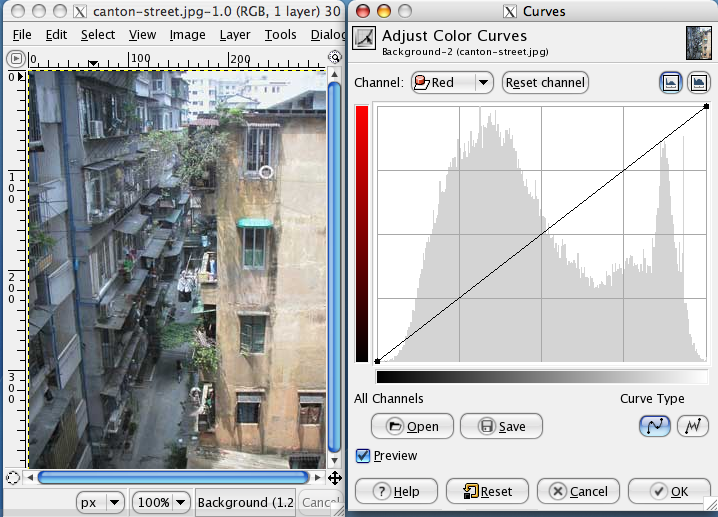Curve (tonality) on:
[Wikipedia]
[Google]
[Amazon]

 In
In
Defanging the Curves Vampire

 In
In image editing
Image editing encompasses the processes of altering images, whether they are Digital photography, digital photographs, traditional Photographic processing, photo-chemical photographs, or illustrations. Traditional analog image editing is known ...
, a curve is a remapping of image tonality, specified as a function from input level to output level, used as a way to emphasize colours or other elements in a picture.
Curves can usually be applied to all channels together in an image, or to each channel individually.
Applying a curve to all channels typically changes the brightness
Brightness is an attribute of visual perception in which a source appears to be radiating/reflecting light. In other words, brightness is the perception dictated by the luminance of a visual target. The perception is not linear to luminance, and ...
in part of the spectrum. Light parts of a picture can be easily made lighter and dark parts darker to increase contrast.
Applying a curve to individual channels can be used to stress a colour. This is particularly efficient in the Lab colour space due to the separation of luminance
Luminance is a photometric measure of the luminous intensity per unit area of light travelling in a given direction. It describes the amount of light that passes through, is emitted from, or is reflected from a particular area, and falls wit ...
and chromaticity
Chromaticity is an objective specification of the quality of a color regardless of its luminance. Chromaticity consists of two independent parameters, often specified as '' hue'' (''h'') and ''colorfulness'' (''s''), where the latter is alte ...
, but it can also be used in RGB
The RGB color model is an additive color model in which the red, green, and blue primary colors of light are added together in various ways to reproduce a broad array of colors. The name of the model comes from the initials of the three ...
, CMYK
The CMYK color model (also known as process color, or four color) is a subtractive color model, based on the CMY color model, used in color printing, and is also used to describe the printing process itself. The abbreviation ''CMYK'' refers ...
or whatever other colour models the software supports.
See also
*Blend modes
Blend modes (alternatively blending modes or mixing modes) in digital image editing and computer graphics are used to determine how two Layers (digital image editing), layers are blended with each other. The default blend mode in most applications ...
* Image histogram
An image histogram is a type of histogram that acts as a graphical representation of the Lightness (color), tonal distribution in a digital image. It plots the number of pixels for each tonal value. By looking at the histogram for a specific ima ...
* Hurter–Driffield curve
Sensitometry is the scientific study of light-sensitive materials, especially photographic film. The study has its origins in the work by Ferdinand Hurter and Vero Charles Driffield (circa 1876) with early black-and-white emulsions. They determ ...
* Tone reproduction curve
References
{{reflistExternal links
Defanging the Curves Vampire
Dan Margulis Dan Margulis (born 21 December 1951) is an expert on color correction and reproduction of photographs, using Adobe Photoshop or similar software.
His ''Professional Photoshop'' series (first edition 1994, currently in its fifth edition, 2006) is wi ...
, December, 1996
Digital photography
Image processing